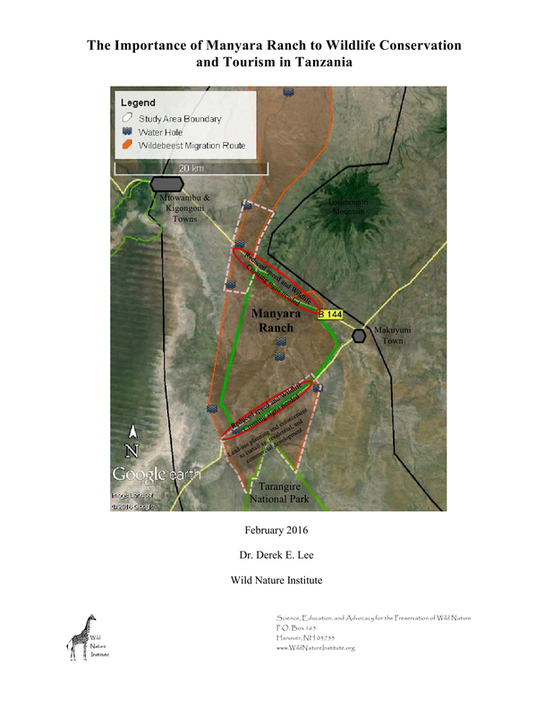Northern Plains Connectivity Campaign
Community Conservation of Masai Cultural Mobility and Wildlife Migration
The Tarangire Ecosystem of northern Tanzania holds one of the last large mammal migrations on earth, but is endangered by habitat loss and poaching. The last best remaining breeding ground for Tarangire migratory wildlife is the Northern Plains, but the migration route from Tarangire National Park to the Northern Plains is threatened. Promising community conservation efforts are underway to give local villagers ownership of wildlife resources and the chance to benefit economically through ecotourism.
Our goal is to protect the connectivity of the wildlife migration route from Tarangire to the Northern Plains by protecting Masai cultural mobility across these rangelands. We are supporting community conservation through land-use planning, Masai warrior anti-poaching patrols, and grassroots ecotourism.
Our environmental education campaign has supported the creation of village environmental forums for community organizing. We have produced a multi-language children's book to educate Masai villagers about the importance of this migration corridor and the benefits they could receive from wildlife-based eco-tourism. These books are distributed to schools and homes throughout the corridor as part of a large-scale campaign to mobilize the communities for conservation.
Our goal is to protect the connectivity of the wildlife migration route from Tarangire to the Northern Plains by protecting Masai cultural mobility across these rangelands. We are supporting community conservation through land-use planning, Masai warrior anti-poaching patrols, and grassroots ecotourism.
Our environmental education campaign has supported the creation of village environmental forums for community organizing. We have produced a multi-language children's book to educate Masai villagers about the importance of this migration corridor and the benefits they could receive from wildlife-based eco-tourism. These books are distributed to schools and homes throughout the corridor as part of a large-scale campaign to mobilize the communities for conservation.
We are supporting community land-use planning for Masai cultural mobility and wildlife migration connectivity throughout the Northern Plains. We and our partners have developed land-use plans, implemented human-wildlife conflict reduction, and started anti-poaching patrols. Wild Nature Institute is collecting wildlife data throughout the area, creating a habitat model of the wildebeest migration, assessing the effectiveness of conservation actions, and improving anti-poaching. Now is an excellent opportunity to support community conservation in Tanzania.
Learn More About The Northern Plains Connectivity Campaign With This Video
DOWNLOAD an article from August 2012 Ujumbe Magazine about our Northern Plains Connectivity Campaign
The Details

- The eastern white-bearded wildebeest that defines the Tarangire Ecosystem is geographically and genetically distinct from the Serengeti wildebeest and represents a unique animal. Numbers of Tarangire wildebeest have plummeted from 40,000 animals in 1988 to just 7,000 in 2014.
- Wildlife tourism in the northern safari circuit enriches Tanzania’s economy by tens of millions of dollars every year, and represents an important long-term source of income – but only as long as land and wildlife resources are managed sustainably.
- The Tarangire Ecosystem and the Northern Plains (shaded green on map at left) between Lake Natron and The Tarangire River represent an area with high growth potential in tourism development. This area is perfectly placed to grow the sector while maintaining a high-quality tourist experience throughout the northern circuit.
- However, the migratory wildlife in the Tarangire Ecosystem must leave the national parks in the wet season to find nutrient-rich forage for reproduction. Eight migration routes for migratory animals have been lost since 1964 due to habitat conversion and permanent settlements; only 2 movement corridors remain and neither are protected.
- The last best remaining wet-season breeding grounds for Tarangire migratory wildlife is the Northern Plains stretching from Tarangire north through Manyara Ranch to the Gelai and Kitumbaine Plains and the shore of Lake Natron (shaded green on map).
- When these animals disappear, tourism dollars will disappear, too. This migration also maintains the ecology of Tarangire and Lake Manyara National Parks, two of the most profitable parks in Tanzania.
A comprehensive, community-driven land-use plan to maintain the connectedness of the Northern Plains migration route will benefit farmers, pastoralists, and tourism businesses so all can thrive.
(Map courtesy of Tom Morrison)
Check out this summary of simple management actions that would help conserve the Tarangire Migration.
Read our scientific article about the Northern Plains wildebeest migration corridor:
M.L. Bond, C.M. Bradley, C. Kiffner, T.A. Morrison & D.E. Lee. 2017. "A multi-method approach to delineate and validate migratory corridors." Landscape Ecology 32:1705-1721.
M.L. Bond, C.M. Bradley, C. Kiffner, T.A. Morrison & D.E. Lee. 2017. "A multi-method approach to delineate and validate migratory corridors." Landscape Ecology 32:1705-1721.
You can make a donation in any amount to support community conservation of this crucial wildlife migration corridor.
|
Mailing Address:
Wild Nature Institute PO Box 44 Weaverville, NC 28787 Phone: +1 415 763 0348 Email: [email protected] |
|
The Wild Nature Institute is a New Hampshire non-profit corporation and a 501(c)3 tax-exempt organization.
© Copyright 2010. All Rights Reserved.


